Table of Contents
The most anticipated holidays of the year are around the corner, Christmas markets with an endless supply of goodies are in full swing, and kitchens are gradually filling up with cookies and eggnog. However, many people dread the critical few days between Christmas and New Year. What if you can’t control yourself again? What if you screw up all your efforts thus far and gain weight? These concerns are quite understandable. After all, delicacies, which you look forward to all year round, are lurking around every corner. But the good news is that you don’t have to give them up and it can be quite easy to stay in shape. We’ll tell you how in today’s article.
Is weight gain unavoidable over the Christmas holidays?
Before Christmas, many people have horror scenarios running through their heads, in which they will gain at least 10 kg of body fat just by walking past the Christmas dinner. However, these fears are relatively exaggerated. The dreaded few days between Christmas Day and New Year’s Eve are quite a short time for a few Christmas treats to cause such massive weight gain. Actually, it’s almost impossible. Because in order to gain 10 kg of fat, you’d have to consume at least 77,000 kcal. This amount of energy can be found, for example, in 14.5 kg of chocolate or 136 kg of apples. Various studies say that the weight gain is usually around only 0.5-1 kg. [1]
A higher number on the scale may not even mean that you have gained body fat. The weight also depends on the current contents of the intestines, the phase of the menstrual cycle or the time of weighing. Changes in weight are also caused by different stores of glycogen in the muscles, which increase after a rich carbohydrate meal, which increases the weight of the muscles. A gram of glycogen binds approx. 3 g of water. [10, 11]
However, if you completely switch to “Christmas mode”, when you eat from sunrise to sunset and your only movement is walking between your fridge and TV, the change in the number on the scale can be more significant. It still wouldn’t reach the mentioned 10 kg.

However, you should also take into consideration that the season of Christmas feasting doesn’t begin on Christmas Day. If the scale really shows 5-10 kg more than the last time you weighted yourself, it is very likely that the weight gain started already at the time when the first lights and chocolate Santas started to appear in stores. Or probably even earlier. Meaning that the extra weight was gained gradually for several weeks or months. At the end of the day, that means that it’s not so much the small mistakes you make between Christmas Day and New Year that matter, but how you eat throughout the whole year.
For many people, the period before Christmas gets out of control precisely because of the food that they have been waiting for all year, various Christmas social events and less physical activity. Although you often don’t really realize it, you consume more food and at the same time move less.
Which situations are the most critical?
- You meet with friends more often, attend more Christmas parties, Christmas markets and similar events where there is a lot of delicious food and drinks.
- Both the pantry and the fridge suddenly look different and are full of festive dishes and food.
- You significantly change the selection of food and many daily meals consist of some Christmas specialties.
- You spend a lot of time sitting in front of the TV, watching Christmas movies and fairy tales.
- You don’t go to work during the holidays and you miss the movement you’re used to.
- You rest a lot, which is why you often limit housework, which is otherwise a normal part of your weekly exercise.
However, none of the points mentioned above can be said to be wrong, and these situations should be avoided completely. Rest, family time and good food are synonymous with Christmas. However, if you are aware that you are more prone to change your patterns during the holidays and you’d like to avoid having to lose weight post-Christmas, it is advantageous to think about where small painless changes could be made. The result can be a quality Christmas time spent, as well as an unchanged number on the scale.
If you are further interested in the topic of Christmas and weight gain, read our article Can You Gain Five Kilos Over Christmas?
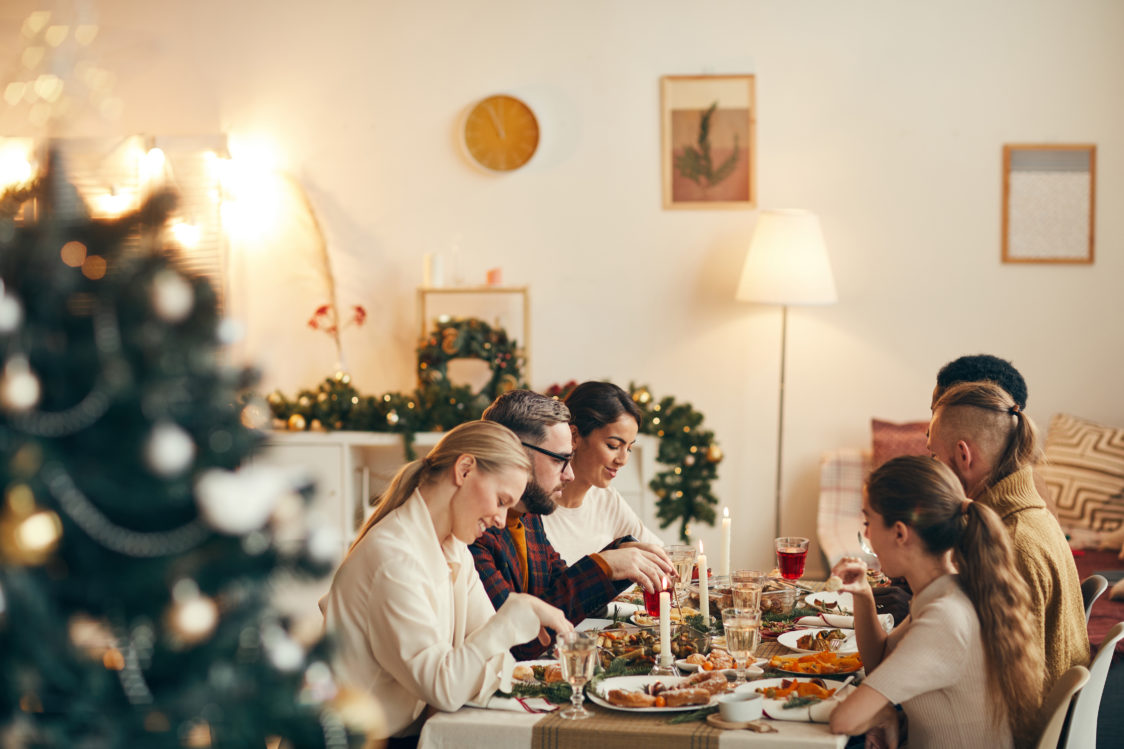
How to stay in shape over Christmas?
1. Try to keep as many pre-Christmas habits as possible
A slight derailment from the normal routine is part of the holidays, and that’s okay. However, if your diet becomes an uncontrollable rollercoaster, it is likely to lead to weight gain. That is why it is beneficial to keep some of the basic pillars of your diet and enjoy the Christmas treats just sporadically.
What to keep in mind even during the holidays?
- The basis of any proper diet is regularity. Whether you are used to eating four or six meals a day, it is advisable to maintain a similar frequency and time distribution of meals. If you limit yourself too much in the amount of food in order to “leave room” for some holiday special, it is possible that you won’t be able to hold back later. In that case you are very likely to overdo it with the amount of food. If, on the other hand, you add to the number of daily meals, you can very easily take in an excessive amount of energy. [7]
- Even during the holidays, keep in mind the composition of your meals. Each main meal should contain complex carbohydrates, protein, fat and fibre. If you don’t miss out on any of the mentioned nutrients, the food will fill you up and then it will be easier for you to control your intake of cookies and other Christmas treats. You can learn more about how to put together a healthy meal in the article What Is a Healthy Diet and How to Learn to Eat Healthy. [2]
- Vegetables and fruits should remain a regular part of the diet. Even during Christmas, you should eat at least 400 g of vegetables and fruits per day, while vegetables should predominate. These foods will provide you with important fibre, which will satiate you and help prevent excessive consumption of less suitable foods. [9]
- Also, don’t eliminate other healthy foods you normally consume from your diet. Whole grain products, legumes, dairy products with a lower fat content, fish or lean meat should have their place in your diet even during the holidays. [2,8]
You might be interested in these products:
2. Control the amount of food and portion sizes
The holidays are often tempting to treat yourself and put a bigger portion on your plate. However, larger portions also mean higher energy intake. Therefore, if you want to ensure that the number on the scale doesn’t rise too much, it is necessary to control the amount of energy-rich holiday foods you consume. The “risky” ones include not only Christmas cookies, but also fried foods, thick soups with a high content of added fat and fatty meat, fatty sausages, energy-rich alcoholic drinks and other traditional snacks.

What can help you control portions?
- You can try putting the “risky” dishes on smaller plates. People often eat with their eyes and eat as much as the plate allows, even though even a smaller portion could sufficiently satiate and satisfy.
- For some food lovers, a small amount might not be enough and they might need a large and hearty portion of their favourite holiday food to be satisfied. Even that might not even be an issue if the food intake during the rest of the day is adequate. In addition, it is possible that if you enjoy your favourite dish with everything that goes with it, it will satisfy you in such a way that it will be easier to resist another portion.
- A good compromise is also the combination of energy-rich foods with those with a lower energy content. For example, a hearty potato salad with mayonnaise can be partially replaced with mashed potatoes.
- Consumption of small cookies and similar goodies, which always miraculously disappear from the plate, can be reduced by loading only a certain amount on a plate. If you fill up a whole tray full of gingerbreads to nibble on whilst watching a Christmas movie in the evening, you’ll probably be horrified when you find out that the tray is empty and the movie hasn’t even finished yet. However, if you put just a few pieces on a small plate and hide the rest in the pantry, it will be easier to control yourself.
3. Don’t forget about protein
Generally, the tastiest dishes are mostly rich in carbohydrates, sugar and fat, and this also applies to the Christmas menu. On the contrary, many of these delicacies lack protein. This is the nutrient that has the greatest ability to satiate.
A good example is any Christmas cookies. One would think that if you treat yourself to a few pieces, you’d be satiated and hunger would be successfully fought off for a longer period of time. But in reality, it’s more likely that you quickly digest this delicacy full of sugar and white flour and soon start looking for another portion. In addition, the high content of simple sugar, which is quickly absorbed from the intestine into the blood, causes fluctuations in blood sugar (glycemia). These can subsequently cause more sweet cravings, which lead us to a vicious circle of hunger and plates full of food.
Protein could disrupt this circle. It ensures that you feel full for a longer time after eating. In addition, protein slows down the absorption of carbohydrates and simple sugars into the bloodstream, thus reducing fluctuations in blood sugar and thus helping to prevent sweet cravings. In the end, both of these effects lead to the fact that you take in a lower amount of food than you would if there wasn’t enough protein in your diet. [2,4]
How to have enough protein in the Christmas menu?
- Treat yourself to a source of protein with every meal. You can choose lean types of meat, fish, eggs, high-quality ham, dairy products, legumes or various plant-based meat alternatives (tofu, seitan, etc.).
- If you have a dish on your plate that is typically low in protein, add more of it. For example, add some yogurt or cream cheese to your Christmas cake with brandy butter.
- Whey or plant-based protein can also serve a good helper if you lack protein.
- You can add a source of protein not only to main meals, but also to treats and cookies. For example, if you add white kefir milk to a cinnamon roll, you will not only satisfy your sweet tooth, but it will also fill you up at the same time. This will reduce the chance that soon you’ll be craving another round.
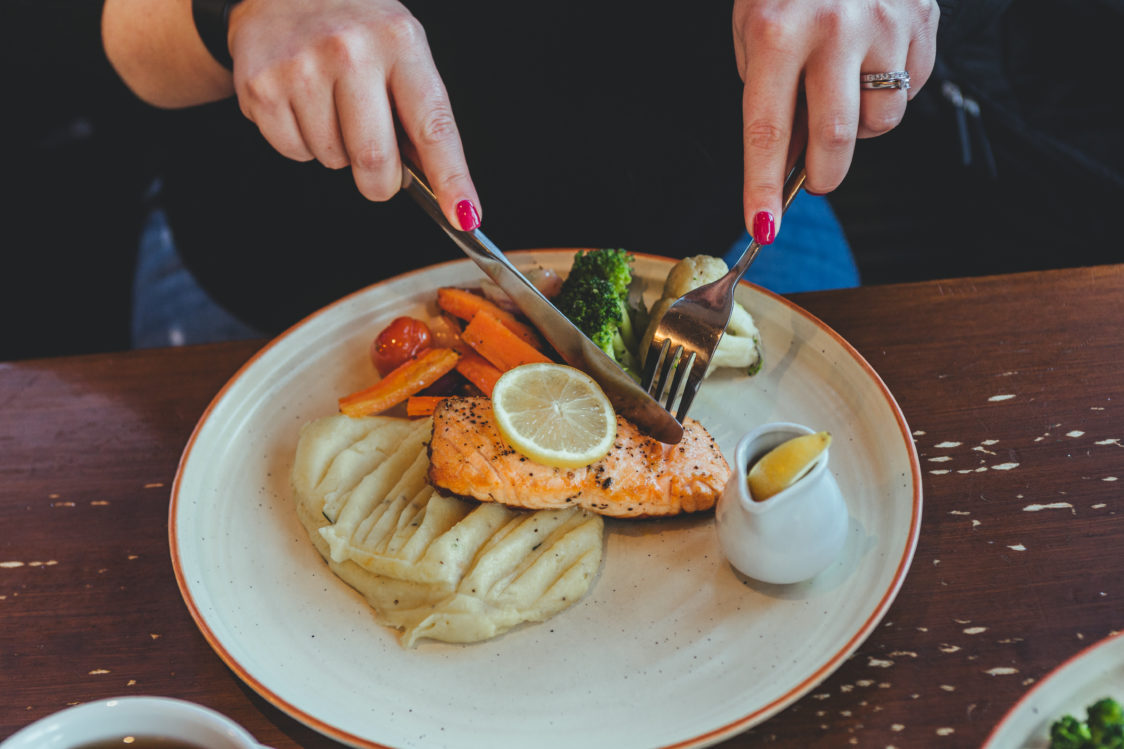
4. Get enough fibre
Fibre supports the feeling of satiety and is therefore a great helper when trying to consume fewer calories. Foods containing fibre help to prevent hunger and sweet tooth. In order to achieve the desired effect, you should consume 25-30 g of fibre per day. [3]
Good sources of fibre are whole grains, legumes, vegetables, fruits, nuts and seeds.
How to have enough fibre in the Christmas menu?
- Choose whole grain bread and other cereal products.
- Include legumes or, for example, pseudocereals (quinoa, amaranth, buckwheat) in your meals. They work great, for example, in soups or spreads.
- Add vegetables to every savoury meal.
- Sweet food, on the other hand, works great with with fruit.
- When baking, you can completely or partially replace white flour with whole grain flour.
- You can also add fibre in the form of a dietary supplement, such as psyllium, apple fibre, glucomannan or a mixture of different types of fibre.

5. Limit nibbling and endless snacking
When there’s food everywhere you look, it’s pretty hard to resist and not eat it. However, this kind of nibbling is often the stumbling block. At that moment, it may seem like it’s only a little bit and nothing bad can happen. However, when these tiny snacks accumulate throughout the day, the calories add up, and a relatively large energy surplus can be created.
Imagine, for example, a day off that you spend at home surrounded by Christmas goodies. In the morning, after breakfast, you reach for a piece of Christmas cake, because it is just that good. Before you get to lunch, you feel hungry again, but you don’t feel like preparing a proper snack, so you have just a handful of dried fruit. After lunch, you feel like having something sweet, so you have a shortcrust cookie. In the course of the afternoon, however, you gradually return for six more of those and drink 200 ml of eggnog. In the evening, you are visiting friends, where you won’t be able to avoid food and alcohol either. Throughout the evening, you’ll eat four vanilla crescent, four cheesy puff pastry straws, and you won’t say no to 300 ml of wine.
How much extra energy would you get in this example?
- 7 shortcrust cookies – 220 kcal
- small piece of Christmas cake – 70 kcal
- 4 vanilla crescents – 180 kcal
- 30 g of dried apricots – 90 kcal
- 4 cheese straws – 250 kcal
- 200 ml of eggnog – 400 kcal
- 300 ml red semi-sweet wine – 220 kcal
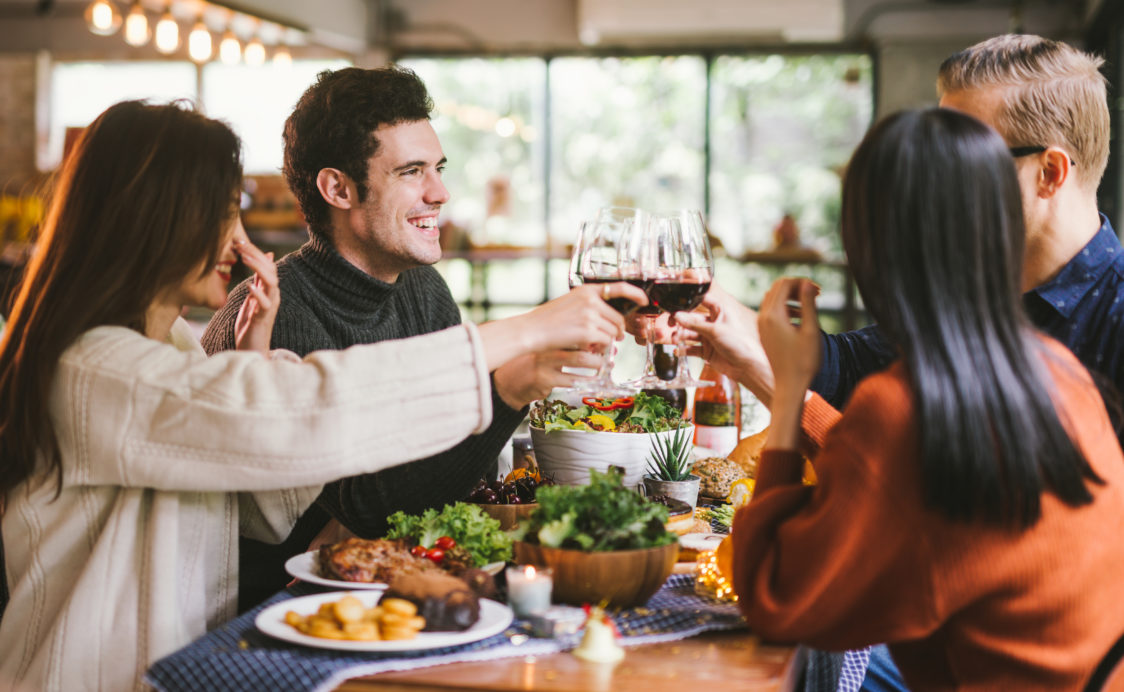
Lists like these are not that uncommon during Christmas period. However, their final energy value may be a surprise. In the mentioned example, it is around 1400 kcal. This means that in this way you would consume the amount of energy that corresponds to roughly 70% of the recommended energy allowance for an average adult. This amount of energy is contained, for example, in three regular portions of sautéed chicken with rice.
You can read more about how nibbling can ruin your weight loss attempts, and what can be done about it in the article How Is Snacking Holding You Back prevent you from Losing Weight? 11 Easy Ways to Get Your Diet Under Control.
6. Indulge only in those treats that are worth it
Everyone has their favourite Christmas goodies without which they cannot imagine the holidays. How about indulging in those in particular and restricting others? If you dream about your grandmother’s vanilla crescents pies a few days before Christmas, eat mainly those. It’s not really necessary to eat a plate of shortcrust cookies just because they are sitting on the table, is it?
Christmas treats are part of Christmas and it’s okay to enjoy them. But you’ll probably enjoy the food even more if you choose one that’s really worth it and stick to it.
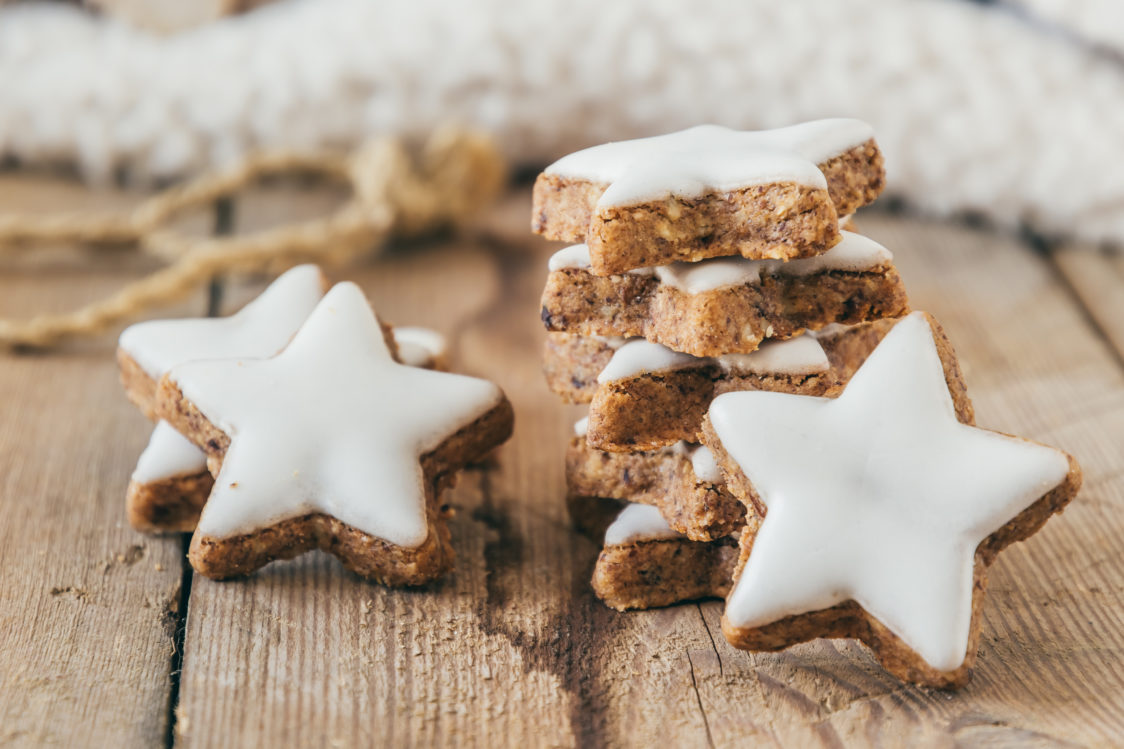
7. Pay attention to the calories in drinks
With the Christmas season comes hand in hand a large number of popular high-calorie drinks. Not only are many people drinking more Coca-Cola and other sugary drinks, but they also drink more alcoholic specialities. Try to keep track of how much mulled wine, eggnog or, for example, punch you drink. These energy bombs contain a large amount of energy in the form of simple sugars and alcohol.
A high intake of these drinks is associated with an increase in body weight and the risk of obesity. No wonder, for example, 200 ml of mulled red wine contains an average of 190 kcal. This amount of energy contains, for example, a breakfast consisting of 150 g of plain yogurt and a large banana. When you drink wine and other drinks in larger quantities, you can take in the amount of energy corresponding to several main meals. [5,6]
You can find out more about how sneaky liquid calories are in our article Where are Liquid Calories Hiding and How Do These Empty Calories Prevent You from Losing Weight?
How much energy is hidden in some drinks?
Drink (200 ml) | Mulled Wine | Eggnog | Semi-Dry Red Wine | Semi-Dry White Wine | 4.7% Beer | |
|---|---|---|---|---|---|---|
Energy Value | 190 kcal | 200 kcal | 170 kcal | 160 kcal | 80 kcal | 90 kcal |
8. Adjust traditional recipes
If you want to reduce the calories in some recipes or increase their nutritional value, there are several ways to achieve this.
- Partially replace white flour with wholemeal flour when baking and cooking.
- Reduce the amount of sugar in recipes or replace it with suitable alternatives. You can use calorie-free erythritol or stevia, low-energy xylitol or, for example, chicory syrup. For sweetening, you can also use fruit, for example banana or grated apple.
- Increase the proportion of protein in sweet recipes. Add yogurt, quark, fermented milk drinks, ricotta, cottage cheese or, for example, whey or plant-based protein.
- Reduce the amount of oil and butter in recipes.
- Replace cream or mayonnaise with yogurt, cottage cheese or semi-skimmed milk.
If you lack inspiration for light Christmas recipes, you might be interested in our Protein Braided Bread, Alcohol-Free Christmas Liqueur, Crescent Cookies or Honey Cake Balls.
If you are more interested in this topic and want to learn how to bake and cook in a healthier way, read the article How to Make Christmas Baking Healthier?
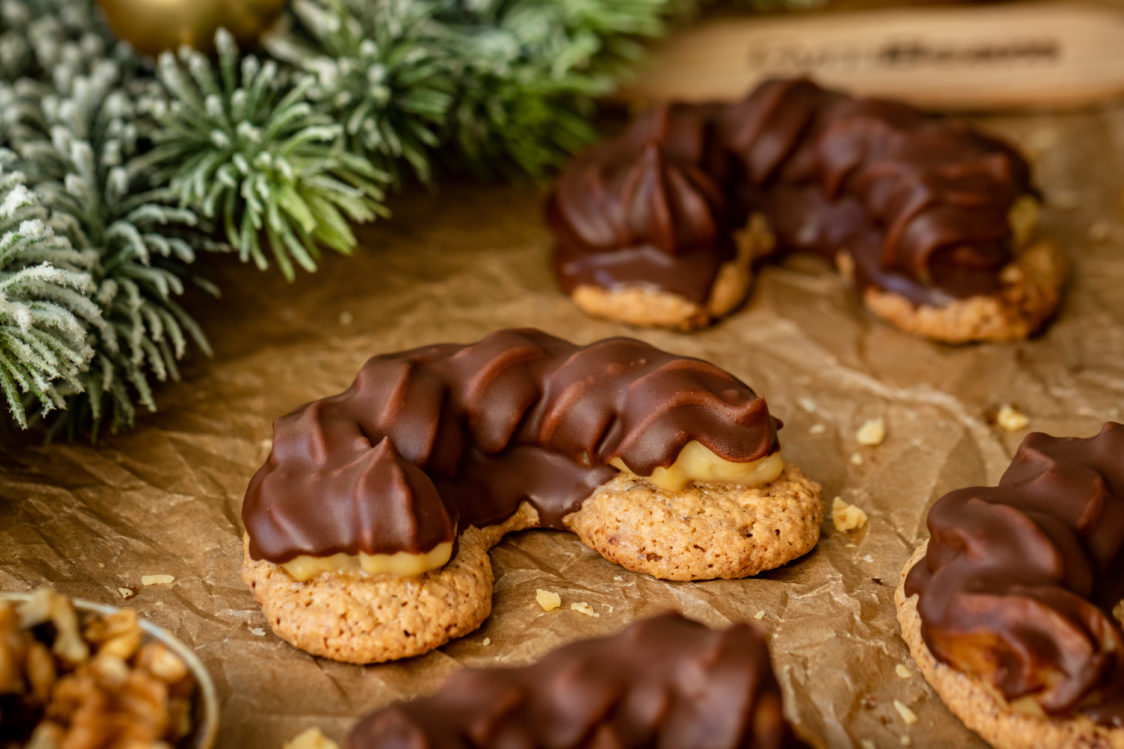
9. Be active
The problem during the Christmas holidays is not only a change in the diet, but also in the exercise patterns. The days are more relaxed, many people don’t have to go to work, and thus the physical activity associated with a normal working day decreases. Instead, you spend more time at home or with relatives, mostly sitting down, and even the most athletic people often prefer laying on the couch to any physical activity.
Holiday period is a good time for trips, walks and various activities with relatives, which are normally postponed due to everyone’s work schedules.
How to increase physical activity during the holidays?
- Go for a walk every day. An average woman weighing 65 kg can burn up to 280 kcal on average in 1 hour of brisk walking at a speed of 5.6 km/h. This is the amount of energy contained in, for example, three bananas. An average man weighing 80 kg can burn up to 340 kcal on the same walk.
- Instead of watching TV all day, go on a trip with your family.
- Engage in winter sports. You can go skiing, cross-country skiing, winter hiking or, for example, ice skating.
- Winter doesn’t have to be a complication for runners and other athletes. Just dress adequately. Holidays are the ideal time to enjoy your favourite sports activities.
- If the weather is suitable, don’t underestimate activities such as snowball fights or shovelling snow. Every little move counts and you’ll have a lot of fun.
If you are interested in how many calories you can burn during the holidays doing various winter activities, read our article How Many Calories Do Your Favourite Winter Activities Burn?

10. Don’t strive for a perfect diet
Many people are determined to resist all temptations during the holidays and maintain their normal routine without fluctuations and “misdemeanours”. But is it necessary? Good food belongs to Christmas and not many people can enjoy it without it. However, if you are one of the lucky ones who are comfortable with it, feel free to stick with it.
However, if you belong to the majority of ordinary mortals who enjoy watching Christmas movies and munching on some Christmas cookies instead, you better relax and enjoy yourself. It’s very likely that you wouldn’t be able to withstand all the restrictions anyway and it could easily lead to overeating. Just treat yourself to some holiday goodies in reasonable quantities every day instead of limiting yourself for a few days and then eating everything that you lay your eyes on until the end of the holidays (or even after).
If you’re interested in even more tips to help keep your eating in check, read our 10 Tips to Avoid Gaining Weight over Christmas.
What should you remember?
The Christmas holidays are a time that belongs to family and loved ones, and is associated it with rest and relaxing days. At the same time, however, it’s a risky period when all your previous efforts for a healthy lifestyle or maintaining body weight could fail. But the good news is that these issues can be easily avoided.
You can maintain the results you achieved during the year without any problems, but it’s important to keep in mind your diet, don’t forget about exercise, and make small changes in your typical holiday habits.
If you liked the article and the information within it was useful for you, make sure to share it with your friends.
[1] DÍAZ-ZAVALA, R.G. et al. Effect of the Holiday Season on Weight Gain: A Narrative Review. – https://www.ncbi.nlm.nih.gov/pmc/articles/PMC5514330/
[2] DUYFF, R.L. Complete Food & Nutrition Guide. New York: Academy of Nutrition and Dietetics, 2017. ISBN 978-0-544-52058-5.
[3] EFSA PANEL ON DIETETIC PRODUCTS, NUTRITION, AND ALLERGIES (NDA) Scientific Opinion on Dietary Reference Values for carbohydrates and dietary fibre. – https://www.efsa.europa.eu/en/efsajournal/pub/1462
[4] EUROPEAN FOOD SAFETY AUTHORITY Scientific Opinion on Dietary Reference Values for protein.– http://onlinelibrary.wiley.com/doi/10.2903/j.efsa.2012.2557/epdf
[5] MALIK, V.S. et al. Intake of sugar-sweetened beverages and weight gain: a systematic review.– https://www.ncbi.nlm.nih.gov/pmc/articles/PMC3210834/
[6] O’DONOVAN, G. et al. Associations between alcohol and obesity in more than 100 000 adults in England and Scotland. – https://www.cambridge.org/core/journals/british-journal-of-nutrition/article/associations-between-alcohol-and-obesity-in-more-than-100-000-adults-in-england-and-scotland/1AF469AB36CC2C3B513E06DC1FFECBAC
[7] ST-ONGE, M.-P. et al. Meal Timing and Frequency: Implications for Cardiovascular Disease Prevention: A Scientific Statement From the American Heart Association. – https://www.ahajournals.org/doi/10.1161/cir.0000000000000476
[8] Dietary Guidelines for Americans, 2020-2025. – https://www.dietaryguidelines.gov/resources/2020-2025-dietary-guidelines-online-materials
[9] WHO| Healthy diet. – http://www.who.int/nutrition/publications/nutrientrequirements/healthydiet_factsheet/en/>
[10] WHITE, P. C. et al. Fluid Retention over the Menstrual Cycle: 1-Year Data from the Prospective Ovulation Cohort. – https://www.ncbi.nlm.nih.gov/pmc/articles/PMC3154522/ BURKE, L. Clinical Sports Nutrition.

